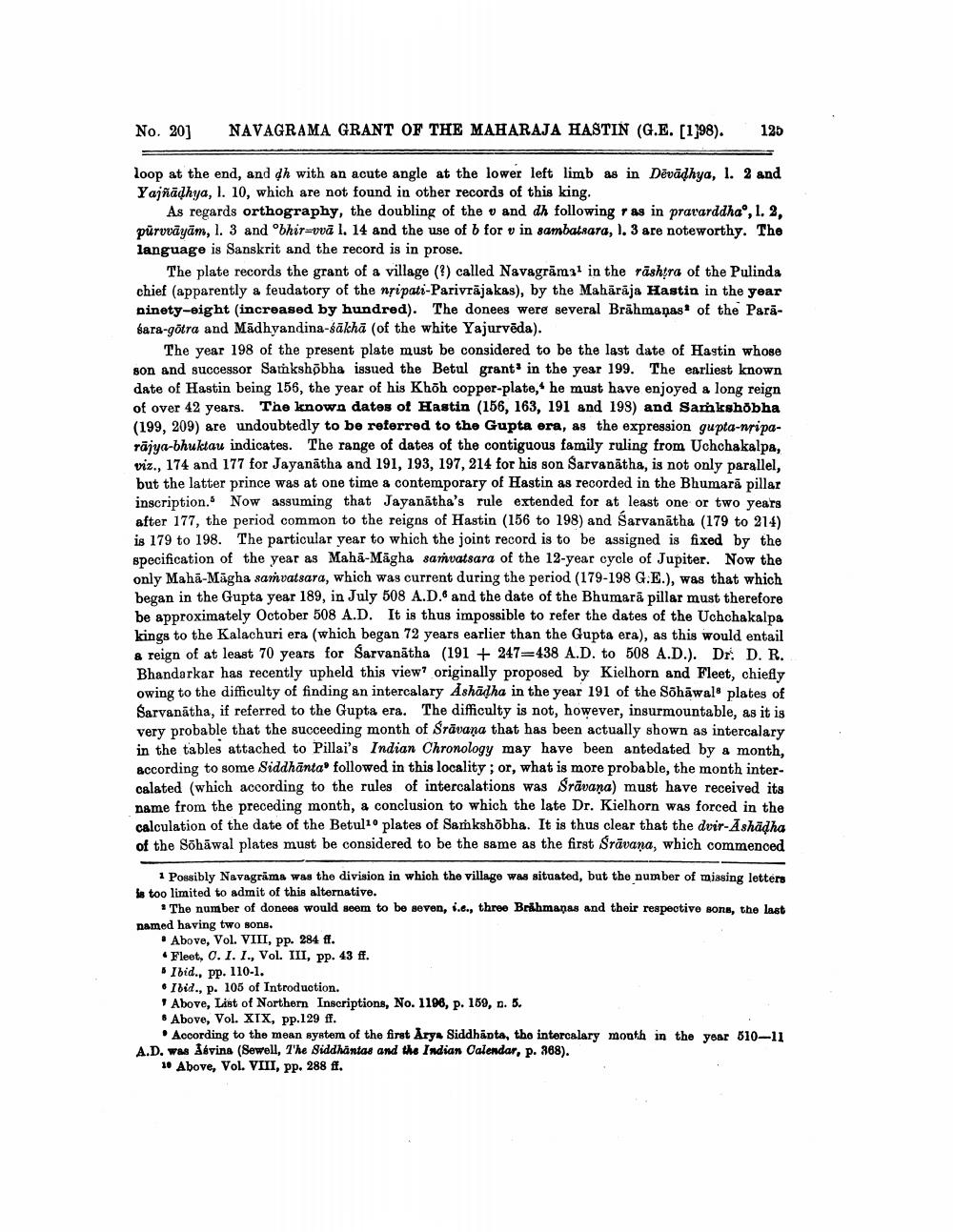________________
No. 20]
NAVAGRAMA GRANT OF THE MAHARAJA HASTIN (G.E. [1398).
loop at the end, and dh with an acute angle at the lower left limb as in Dēvāḍhya, 1. 2 and Yajñāḍhya, 1. 10, which are not found in other records of this king.
125
As regards orthography, the doubling of the v and dh following r as in pravarddha, 1.2, pūrvvāyām, 1. 3 and °bhir-vvā 1. 14 and the use of b for v in sambatsara, 1. 3 are noteworthy. The language is Sanskrit and the record is in prose.
The plate records the grant of a village (?) called Navagrāma1 in the rashtra of the Pulinda chief (apparently a feudatory of the nṛipati-Parivrajakas), by the Mahārāja Hastin in the year ninety-eight (increased by hundred). The donees were several Brahmanas of the Parasara-gōtra and Madhyandina-sakhā (of the white Yajurvēda).
The year 198 of the present plate must be considered to be the last date of Hastin whose son and successor Samkshobha issued the Betul grant in the year 199. The earliest known date of Hastin being 156, the year of his Khōh copper-plate, he must have enjoyed a long reign of over 42 years. The known dates of Hastin (156, 163, 191 and 198) and Samkshōbha (199, 209) are undoubtedly to be referred to the Gupta era, as the expression gupta-nriparajya-bhuktau indicates. The range of dates of the contiguous family ruling from Uchchakalpa, viz., 174 and 177 for Jayanatha and 191, 193, 197, 214 for his son Sarvanatha, is not only parallel, but the latter prince was at one time a contemporary of Hastin as recorded in the Bhumară pillar inscription. Now assuming that Jayanatha's rule extended for at least one or two years after 177, the period common to the reigns of Hastin (156 to 198) and Sarvanatha (179 to 214) is 179 to 198. The particular year to which the joint record is to be assigned is fixed by the specification of the year as Maha-Magha samvatsara of the 12-year cycle of Jupiter. Now the only Maha-Magha samvatsara, which was current during the period (179-198 G.E.), was that which began in the Gupta year 189, in July 508 A.D. and the date of the Bhumara pillar must therefore be approximately October 508 A.D. It is thus impossible to refer the dates of the Uchchakalpa kings to the Kalachuri era (which began 72 years earlier than the Gupta era), as this would entail a reign of at least 70 years for Sarvanatha (191 + 247-438 A.D. to 508 A.D.). Dr. D. R. Bhandarkar has recently upheld this view' originally proposed by Kielhorn and Fleet, chiefly owing to the difficulty of finding an intercalary Ashadha in the year 191 of the Sōhawal plates of Sarvanatha, if referred to the Gupta era. The difficulty is not, however, insurmountable, as it is very probable that the succeeding month of Śrāvana that has been actually shown as intercalary in the tables attached to Pillai's Indian Chronology may have been antedated by a month, according to some Siddhanta followed in this locality; or, what is more probable, the month intercalated (which according to the rules of intercalations was Śrāvana) must have received its name from the preceding month, a conclusion to which the late Dr. Kielhorn was forced in the calculation of the date of the Betul1o plates of Samkshōbha. It is thus clear that the dvir-Ashāḍha of the Sōhawal plates must be considered to be the same as the first Śrāvana, which commenced
1 Possibly Navagrāma was the division in which the village was situated, but the number of missing letters is too limited to admit of this alternative.
The number of donees would seem to be seven, i.e., three Brahmanas and their respective sons, the last named having two sons.
Above, Vol. VIII, pp. 284 ff.
Fleet, C. I. I., Vol. III, pp. 43 ff.
Ibid., pp. 110-1.
Ibid., p. 105 of Introduction.
Above, List of Northern Inscriptions, No. 1196, p. 159, n. 5.
Above, Vol. XIX, pp.129 ff.
According to the mean system of the first Arya Siddhanta, the intercalary month in the year 510-11 A.D. was Jévina (Sewell, The Siddhäntas and the Indian Calendar, p. 388).
10 Above, Vol. VIII, pp. 288 ff.




